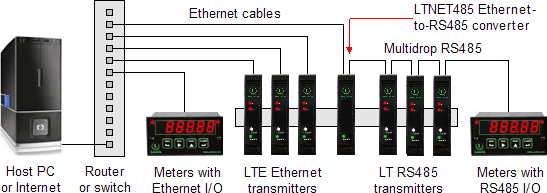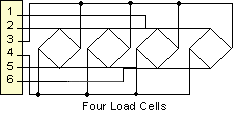
MLTE-SG | Ethernet & 4-20 mA Output | Strain Gauge or Potentiometer Follower | DIN Rail Transmitter
A built-in, isolated, 10V, 120 mA excitation supply can power up to four 350-ohm load cells in parallel. Load cell connection can be via 4 or 6 wires. With 4-wire load connection, the transmitter operates in a ratiometric mode to eliminate errors due to power supply variations. With 6-wire load connection, it also compensates for lead resistance, allowing long cable runs.
Fast read rate at up to 50 or 60 conversions per second while integrating the signal over a full power line cycle is provided by Concurrent Slope (Pat 5,262,780) analog-to-digital conversion. High read rate is ideal for peak or valley capture and for real-time computer interface and control.
Digital signal filtering modes are selectable for stable readings in electrically noisy environments.
- An unfiltered selection provides true peak and valley readings and aids in control applications.
- A batch average filter selection averages each 16 conversions for an update every 1/4 sec.
- An adaptive moving average filter selection provides a choice of 8 time constants from 80 ms to 9.6 s. When a significant change in signal level occurs, the filter adapts by briefly switching to the shortest time to follow the change, then reverts back to its selected time constant. An Auto setting selects the time constant selection based on signal noise.
Standard features of Micron MLTE transmitters include:
- Ethernet I/O, isolated. Supported protocols are Modbus RTU and ASCII (tunneled via Modbus TCP) and Custom ASCII. The latter is simpler than the Modbus protocol and is recommended when all devices are Micron units. Note that RS232 or RS485 data I/O in lieu of Ethernet is provided by LT Series transmitters.
- 4-20 mA, 0-20 mA or 0-10V analog transmitter output, isolated, jumper-selectable and user scalable. All selections provide 16-bit (0.0015%) resolution of output span and 0.02% output accuracy of a reading from -99,999 to +99,999 counts that is also transmitted digitally. Output isolation from signal and power grounds eliminates potential ground loop problems. The supply can drive 20 mA into a 500 ohm (or lower) load for 10V compliance, or 10V into a 5K ohm (or higher) load for 2 mA compliance.
- Dual solid state relays, isolated. Available for local alarm or control. Rated 120 mA at 130 Vac or 180 Vdc.
- Universal 85-264 Vac power. Low-voltage 10-48 Vdc or 12-32 Vac power is optional.
Discovery and configuration of the Ethernet Nodes is easily achieved with the Node Manager Software, and the discovered transmitters can then be programmed using the Instrument Setup Software. Both software's run on a PC under MS Windows and can be downloaded from this website at no charge.

Load Cell Transmitter Connections
 In 4-wire connection, the excitation and sense lines are tied
together. The transmitter can make ratiometric corrections for supply
voltage variations, but does not compensate for variations in lead
resistance. This connection is often used with short cable runs.
In 4-wire connection, the excitation and sense lines are tied
together. The transmitter can make ratiometric corrections for supply
voltage variations, but does not compensate for variations in lead
resistance. This connection is often used with short cable runs.
 In 6-wire connection, the sense lines are separate from the
excitation lines, thereby eliminating effects due to variations in lead
resistance. This allows long cable runs in outdoor environments with
temperature extremes.
In 6-wire connection, the sense lines are separate from the
excitation lines, thereby eliminating effects due to variations in lead
resistance. This allows long cable runs in outdoor environments with
temperature extremes.
 For large scales, up to four 350 ohm load cells can be powered by
a single Laureate, whose excitation output is rated 120 mA at 10V. The
excitation and sense points of the four bridges are connected in
parallel. The load cell outputs will be averaged if the load cells have
the same sensititivity in mV/V.
For large scales, up to four 350 ohm load cells can be powered by
a single Laureate, whose excitation output is rated 120 mA at 10V. The
excitation and sense points of the four bridges are connected in
parallel. The load cell outputs will be averaged if the load cells have
the same sensititivity in mV/V.
![]() Micron MLTE-SG | Support Library
Micron MLTE-SG | Support Library
Data Sheet | User Manual
